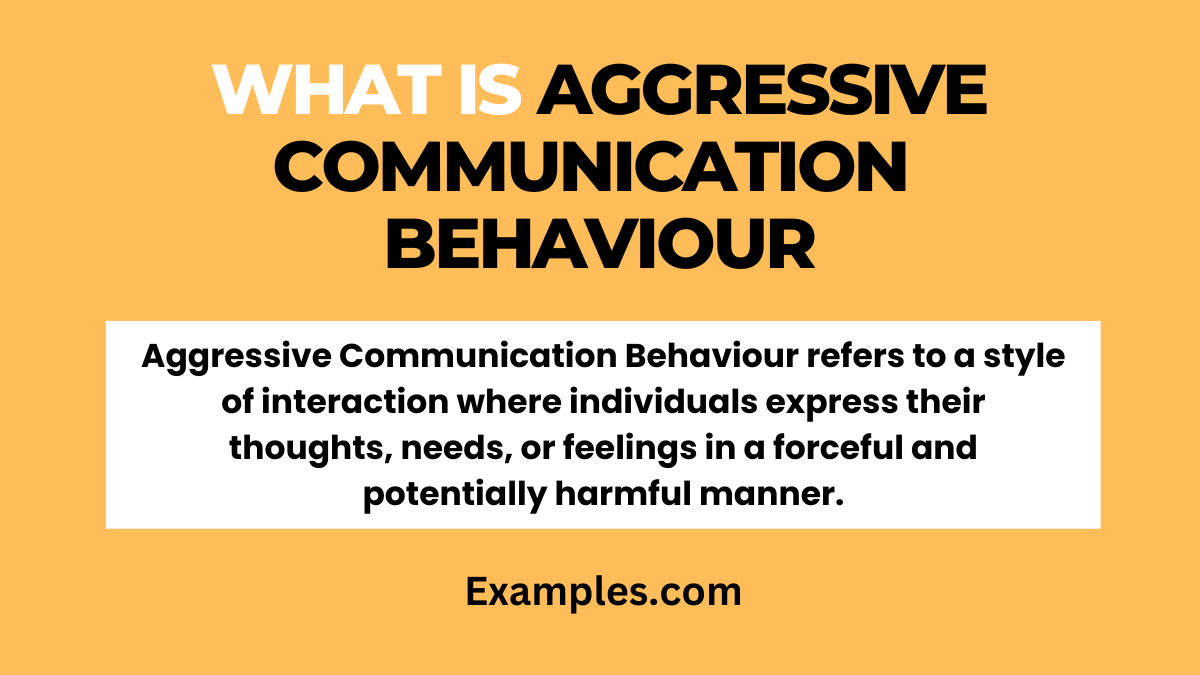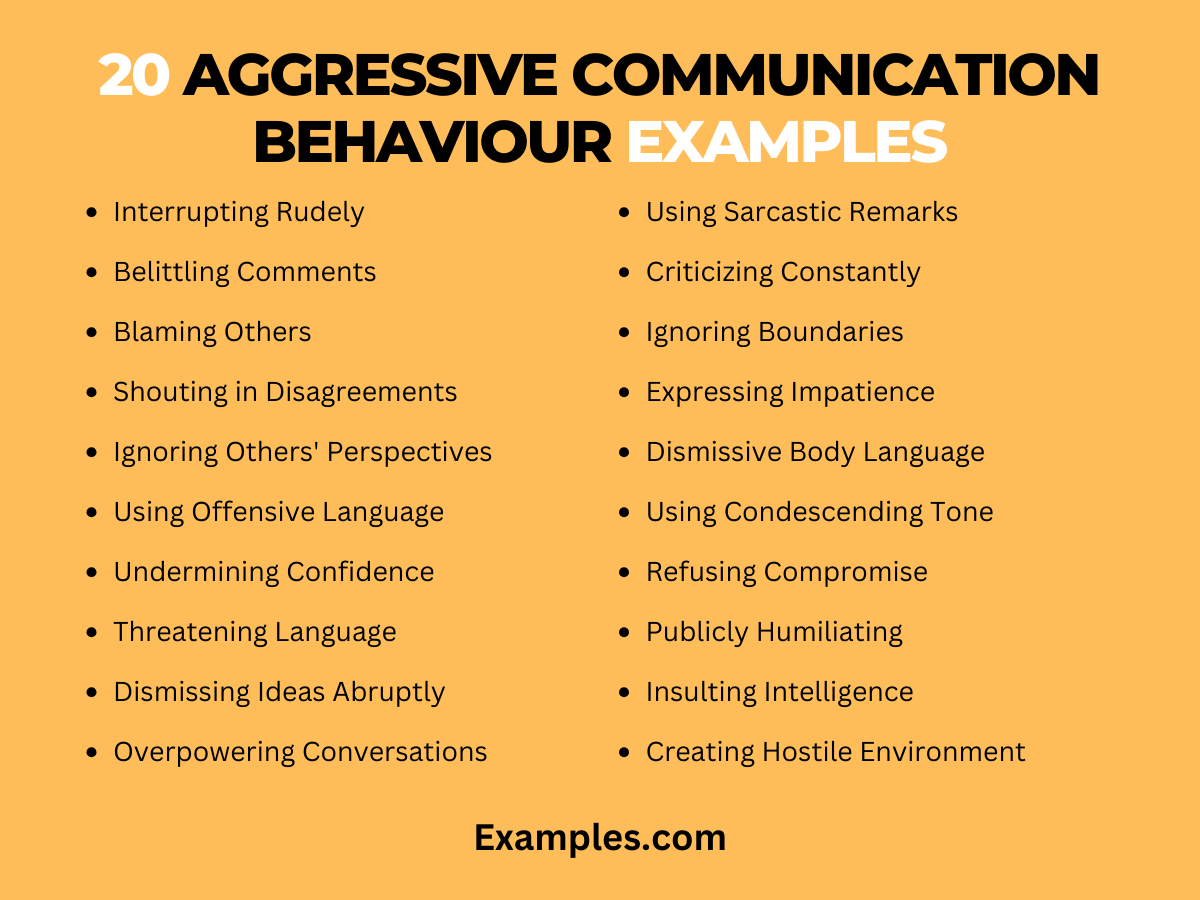20+ Aggressive Communication Behaviour Examples
Unlock the secrets of effective communication with our comprehensive guide to Aggressive Communication Behaviour. Discover nuanced examples that illuminate this behavioural aspect, equipping you with valuable insights to navigate both the classroom and workplace. From assertive strategies to handling aggressive scenarios, this guide provides actionable tips for improved interpersonal dynamics. Elevate your communication skills and gain a deeper understanding of communication examples for enhanced effectiveness in various social settings. Communication examples take centre stage in this essential guide for mastering assertive interactions.
What is Aggressive Communication Behaviour? – Definition

Aggressive Communication Behaviour refers to a style of interaction where individuals express their thoughts, needs, or feelings in a forceful and potentially harmful manner. This communication approach often involves dominating conversations, ignoring others’ perspectives, and can lead to a hostile environment. In simpler terms, it’s a way of expressing oneself that can be overpowering and detrimental to effective dialogue. Understanding this behaviour is crucial for fostering healthier communication dynamics and promoting more positive interactions in various contexts.
20 Aggressive Communication Behaviour Examples
Explore the advantages of recognizing and addressing Aggressive Communication Behaviour with our insightful guide. Discover how understanding this behaviour can lead to more positive interactions in both personal and professional settings.

- Interrupting Rudely:
- Bold and assertive communication can express your views without interrupting rudely, fostering a more respectful conversation.
- Belittling Comments:
- Avoid making belittling comments; instead, offer constructive feedback to promote a supportive dialogue.
- Blaming Others:
- Taking responsibility for mistakes rather than blaming others demonstrates accountability and encourages open communication.
- Shouting in Disagreements:
- Express disagreements without shouting; a calm tone helps maintain a conducive environment for discussion.
- Ignoring Others’ Perspectives:
- Acknowledge and consider others’ perspectives, creating a space for diverse opinions and collaborative problem-solving.
- Using Offensive Language:
- Choose respectful language to convey your point, avoiding offensive terms that may escalate tensions.
- Undermining Confidence:
- Encourage confidence in others; undermining can erode trust and hinder effective teamwork.
- Threatening Language:
- Replace threatening language with assertive statements, promoting a safer and more open communication climate.
- Dismissing Ideas Abruptly:
- Instead of dismissing ideas abruptly, provide constructive feedback to encourage innovative thinking.
- Overpowering Conversations:
- Balancing conversations prevents one person from dominating, ensuring everyone has an opportunity to contribute.
- Using Sarcastic Remarks:
- Foster a positive atmosphere by refraining from sarcastic remarks, which can be misinterpreted and hinder communication.
- Criticizing Constantly:
- Constructive criticism contributes to growth, whereas constant criticism may lead to resentment and negativity.
- Ignoring Boundaries:
- Respecting personal boundaries is crucial; ignoring them can lead to discomfort and strained relationships.
- Expressing Impatience:
- Practice patience; expressing impatience can create tension and hinder effective communication.
- Dismissive Body Language:
- Be mindful of body language; dismissive gestures can convey negativity even when words do not.
- Using Condescending Tone:
- Speak with a respectful tone to avoid condescension and encourage open dialogue.
- Refusing Compromise:
- Embrace compromise; refusing to do so can lead to unresolved conflicts and strained relationships.
- Publicly Humiliating:
- Offer constructive criticism privately to avoid public humiliation, fostering a supportive environment.
- Insulting Intelligence:
- Respect others’ intelligence; insulting it can hinder collaboration and breed resentment.
- Creating Hostile Environment:
- Strive for a collaborative environment; creating hostility hinders productivity and damages relationships.
Aggressive Communication Behaviour in the Classroom
Explore the impact of Aggressive Communication Behaviour within educational settings. This guide delves into the dynamics of assertiveness, providing insights on fostering a positive and inclusive learning environment.

- Demanding Answers in a Condescending Tone:
- Encourage respectful discussions by avoiding demanding questions in a condescending tone.
- Publicly Criticizing Classmates:
- Foster a supportive atmosphere by providing constructive feedback privately instead of publicly criticizing peers.
- Ignoring Classmates’ Contributions:
- Promote collaboration by acknowledging and appreciating classmates’ contributions rather than ignoring them.
- Dominating Group Discussions:
- Encourage balanced participation by avoiding the habit of dominating group discussions.
- Undermining Others’ Ideas:
- Cultivate an environment that nurtures creativity by refraining from undermining classmates’ ideas.
Aggressive Communication Behaviour in the Workplace
Navigate the complexities of Aggressive Communication Behaviour in professional settings. This guide offers practical insights for promoting effective communication and fostering a healthy workplace culture.
- Yelling in Disagreements with Colleagues:
- Maintain a professional atmosphere by expressing disagreements without resorting to yelling.
- Undermining Co-workers’ Contributions:
- Boost team morale by recognizing and appreciating co-workers’ contributions instead of undermining them.
- Publicly Criticizing Team Members:
- Promote a positive work environment by offering constructive criticism privately rather than publicly criticizing team members.
- Interrupting Meetings Rudely:
- Enhance meeting effectiveness by promoting a culture of respectful communication and avoiding rude interruptions.
- Using Offensive Language in Conflicts:
- Maintain professionalism during conflicts by refraining from using offensive language that may escalate tensions.
How to Respond to Aggressive Communication Behaviour
Aggressive communication can create challenging situations, but responding effectively is crucial for maintaining positive interactions. Explore this comprehensive guide for practical strategies on handling aggressive communicators and fostering healthier dialogues.
- Stay Calm and Composed: When faced with aggression, remain calm and composed. Responding with emotional control helps de-escalate the situation, setting the tone for a more constructive exchange.
- Active Listening: Practice active listening to understand the aggressive communicator’s perspective. This demonstrates empathy and opens the door to resolving misunderstandings.
- Choose Your Words Wisely: Respond with assertive yet respectful language. Avoid escalating tensions by choosing words that express your point of view without further provoking aggression.
- Set Boundaries: Clearly communicate and reinforce personal boundaries. Establishing limits helps prevent further aggressive behaviour and promotes a more respectful dialogue.
- Address the Behaviour, Not the Person: Focus on the specific behaviour causing concern rather than attacking the individual. This approach encourages a discussion about actions rather than personal attacks.
- Use “I” Statements: Express your feelings using “I” statements to convey your perspective without sounding accusatory. This promotes a more collaborative atmosphere for finding solutions.
- Offer Constructive Feedback: Provide constructive feedback to encourage positive change. Highlight specific actions and suggest alternative approaches to foster improved communication.
- Seek Clarity: Ask clarifying questions to ensure you fully understand the aggressive communicator’s intentions. Seeking clarity can unveil underlying issues that contribute to the aggression.
- Know When to Disengage: Recognize situations where disengaging is necessary. Sometimes, stepping back temporarily can diffuse tension and create space for more productive conversations later.
- Involve a Neutral Third Party: If the aggression persists, consider involving a neutral third party, such as a mediator or supervisor, to facilitate a more objective resolution.
In conclusion, mastering effective communication involves understanding and addressing Aggressive Communication Behaviour. This comprehensive guide has explored examples, strategies, and real-world applications to navigate such situations. By recognizing, responding to, and fostering healthier communication dynamics, individuals can contribute to positive interactions both in personal and professional spheres.



